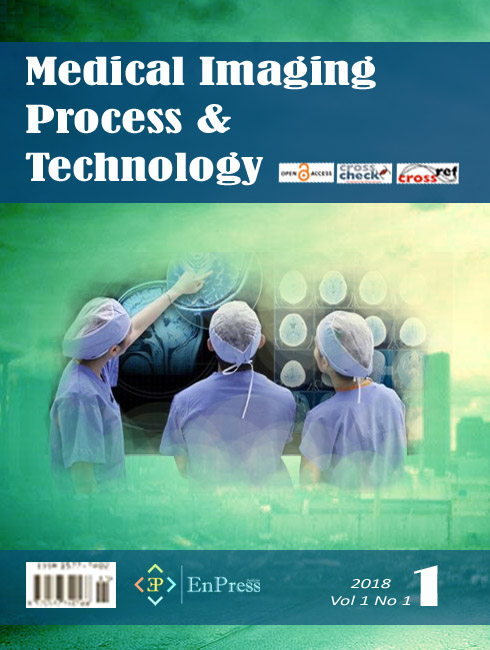|
2578-160X (Online) Journal Abbreviation: Med. Imag. Proc. Tech. |
The purpose of Medical Imaging Process & Technology (MIPT) is to act as a platform for the exchange of research results concerning medical imaging technology in medical detection, prevention, health, etc. Articles published in MIPT will be of interest of medical imaging system and medical image processing, and the scope welcomes the manuscripts from all the medical imaging aspects including imaging diagnostics, radiology, endoscopy, medical thermal imaging technology, medical photography and microscope. The original research is highly regarded, such as visualization, data structure and representation, pattern matching and recognition, object detection, change detection, motion estimation and related methods. |
Online Submissions
Registration and login are required to submit items online and to check the status of current submissions.
Already have a Username/Password for Medical Imaging Process & Technology?
GO TO LOGIN
Need a Username/Password?
GO TO REGISTRATION
Submission Preparation Checklist
As part of the submission process, authors are required to check off their submission's compliance with all of the following items, and submissions may be returned to authors that do not adhere to these guidelines.
- The submission has not been previously published, nor is it before another journal for consideration (or an explanation has been provided in Comments to the Editor).
- The submission file is in Microsoft Word format.
- Where available, URLs for the references have been provided.
- The text adheres to the stylistic and bibliographic requirements outlined in the Author Guidelines, which is found in About the Journal.
- If submitting to a peer-reviewed section of the journal, the instructions in Ensuring a Blind Review have been followed.
Privacy Statement
EnPress Publisher respects and strives to protect the privacy of its users and visitors. Hence, users and visitors are encouraged to read EnPress Publisher’s privacy policy regarding the usage and handling of user information.
(1) User information
Names and email addresses entered in all EnPress Publisher’s journal sites will be used exclusively for the stated purposes of the journals and will not be made available for any other purpose or to any other party. For submission and peer review, users should register an account for further procedures, including but not limited to name, email, address, interests, affiliation, and postcode, as editors need the information to complete in-house processes (e.g., processing a manuscript).
When users visit the publisher's website, information about the visit is saved in web logs (e.g., device, IP address, time of visit, etc.), which are only used to help improve the structure and content of the website.
(2) User rights
Users have the right to register or update their personal information and contact the publisher to cancel/delete their account if required.
(3) Third-party link
EnPress Publisher is not responsible for private information obtained by third-party websites when users log in via a pop-up screen from third-party software installed on their computer.
When users visit third-party platforms (e.g., LinkedIn, Twitter, COPE, etc.) through hyperlinks from EnPress Publisher’s journal websites, the privacy policy follows the policies of the third-party platforms.
(4) Queries or contact
For any queries about EnPress Publisher’s privacy policy, please contact the editorial office at editorial@enpress-publisher.com.
Article Processing Charges (APCs)
Medical Imaging Process & Technology is an Open Access Journal under EnPress Publisher. All articles published in Medical Imaging Process & Technology are accessible electronically from the journal website without commencing any kind of payment. In order to ensure contents are freely available and maintain publishing quality, Article Process Charges (APCs) are applicable to all authors who wish to submit their articles to the journal to cover the cost incurred in processing the manuscripts. Such cost will cover the peer-review, copyediting, typesetting, publishing, content depositing and archiving processes. Those charges are applicable only to authors who have their manuscript successfully accepted after peer-review.
| Journal Title | APCs |
|---|---|
| Medical Imaging Process & Technology | $1000 |
We encourage authors to publish their papers with us and don’t wish the cost of article processing fees to be a barrier especially to authors from the low and lower middle income countries/regions. A range of discounts or waivers are offered to authors who are unable to pay our publication processing fees. Authors can write in to apply for a waiver and requests will be considered on a case-by-case basis.
*Article No. is mandatory for payment and it can be found on the acceptance letter issued by the Editorial Office. Payment without indicating Article No. will result in processing problem and delay in article processing. Please note that payments will be processed in USD. You can make payment through Masters, Visa or UnionPay card.
Vol 8, No 1 (2025)
Table of Contents
Medical image fusion plays a crucial role in combining complementary information from multimodal medical images, enhancing diagnostic accuracy and clinical decision-making. This paper presents a novel modified Non-Subsampled Contourlet Transform (NSCT)-based algorithm for enhanced medical image fusion. The proposed method incorporates adaptive fusion rules designed to maximize detail preservation, structural similarity, and edge retention while maintaining computational efficiency. Comprehensive experiments were conducted on multiple imaging modalities, including Magnetic Resonance Imaging (MRI), Positron Emission Tomography (PET), Magnetic Resonance Angiography (MRA), and Single Photon Emission Computed Tomography (SPECT), and evaluated using metrics such as Peak Signal-to-Noise Ratio (PSNR), Structural Similarity Index (SSIM), Entropy (EN), and Edge Preservation Index (EPI). The results demonstrate that the proposed method consistently outperforms traditional fusion techniques, delivering superior fusion quality and robustness across modalities.
Announcements
The Conflict of Interest Policy statement |
|
Conflicts of interest may exist when professional judgements concerning a primary interest has the possibility of being influenced by a secondary interest (e.g.: financial gains). It is to be noted that even perceptions of conflicts of interest are as important as the actual conflicts of interest. |
|
| Posted: 2022-09-13 | More... |
The 33rd Annual ASE Scientific Sessions will be held on 10th -13th June, 2022 |
|
 The 33rd Annual ASE Scientific Sessions will be held on 10-13 June, 2022 in Seattle, Washington, USA. The Scientific Sessions is the premier international conference dedicated to the use of cardiovascular ultrasound in clinical patient care. |
|
| Posted: 2022-04-10 | More... |
Summary of recommended conferences in medical imaging field |
|
In the field of medical imaging, there are several recommended conferences as followed:
|
|
| Posted: 2021-06-26 | More... |
| More Announcements... |



 ISSN:
ISSN: Open Access
Open Access
